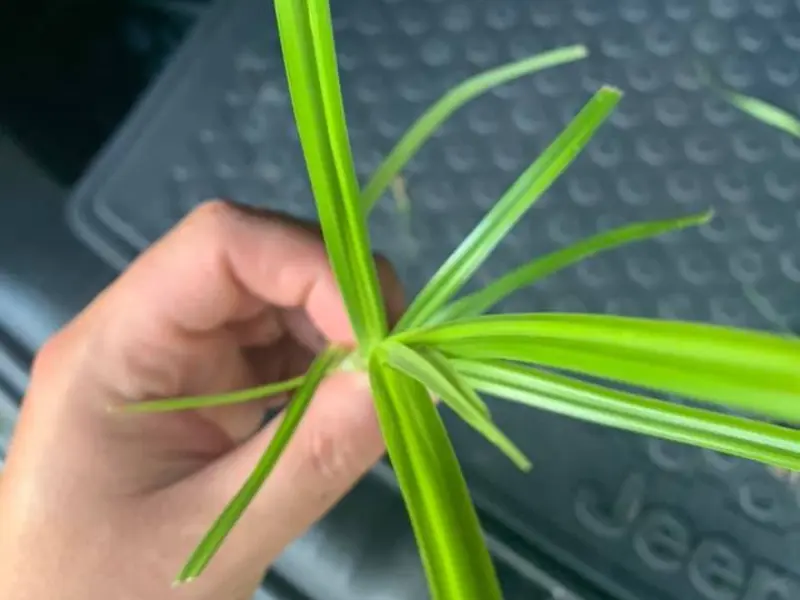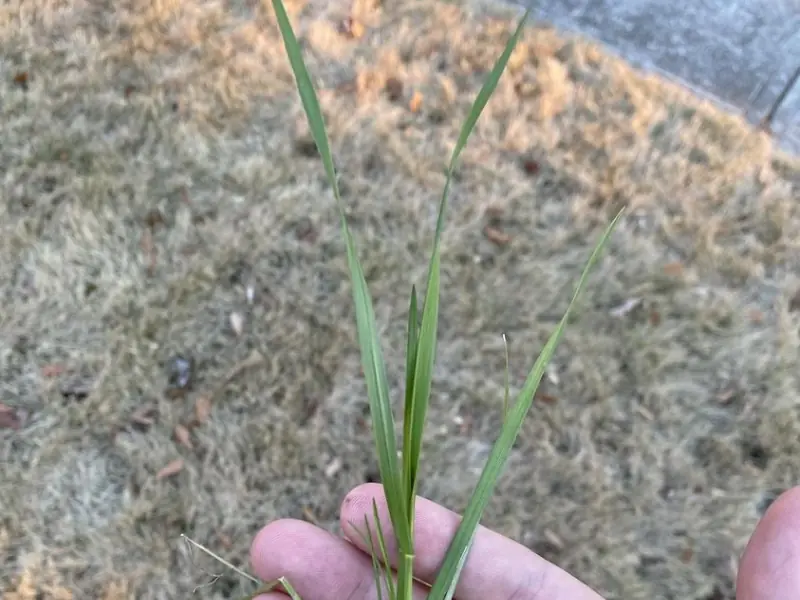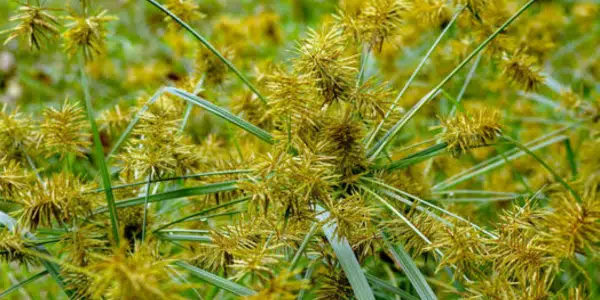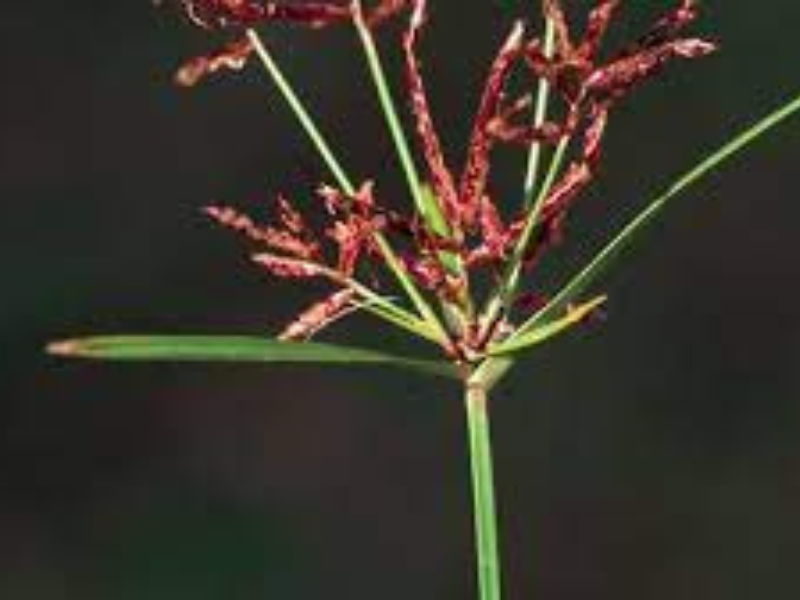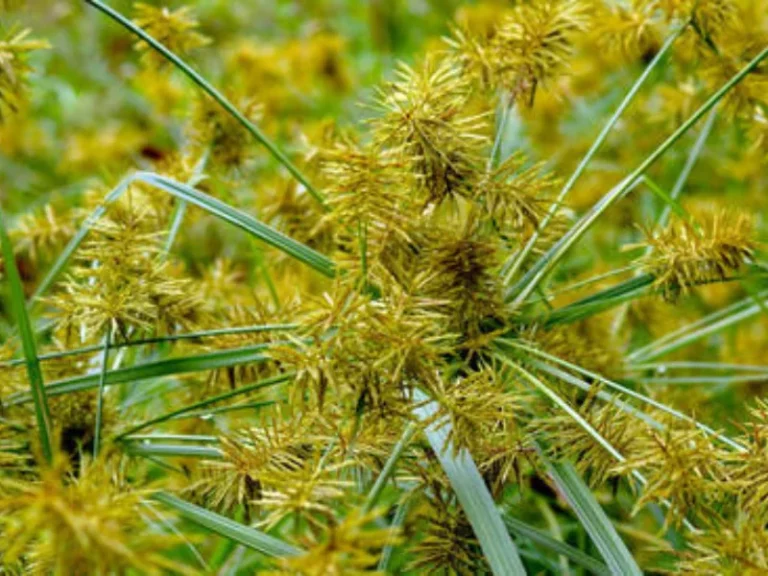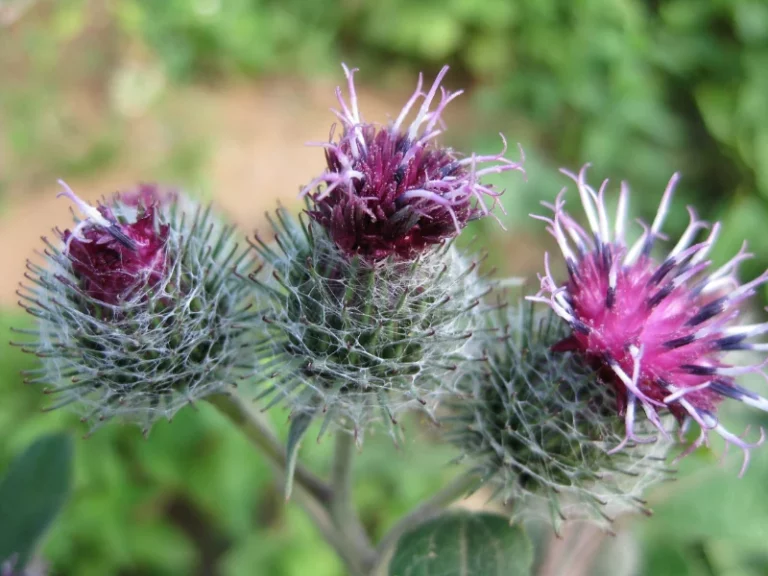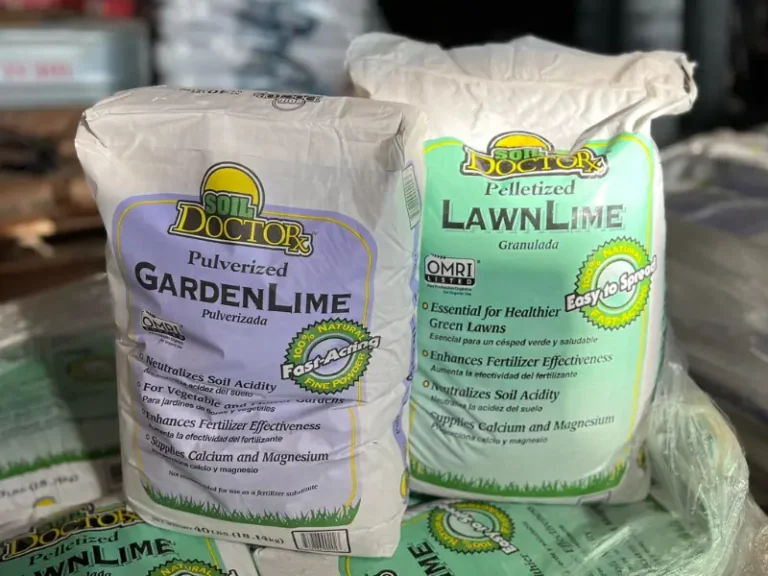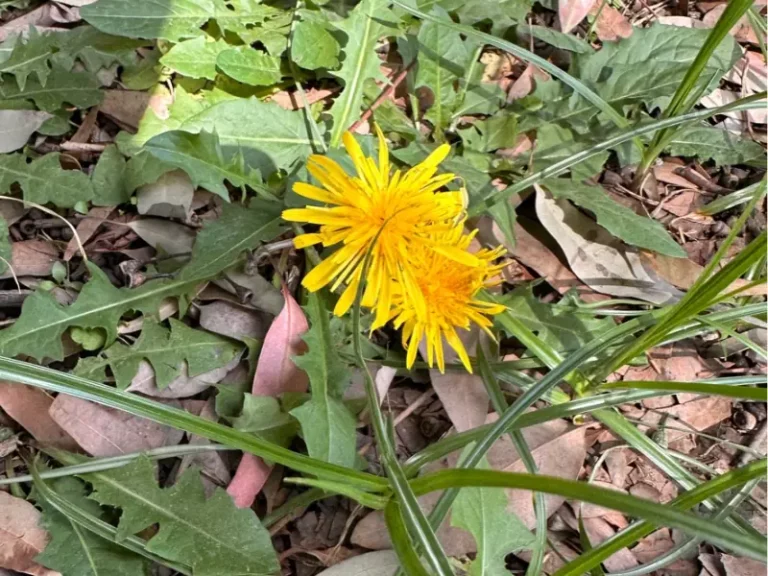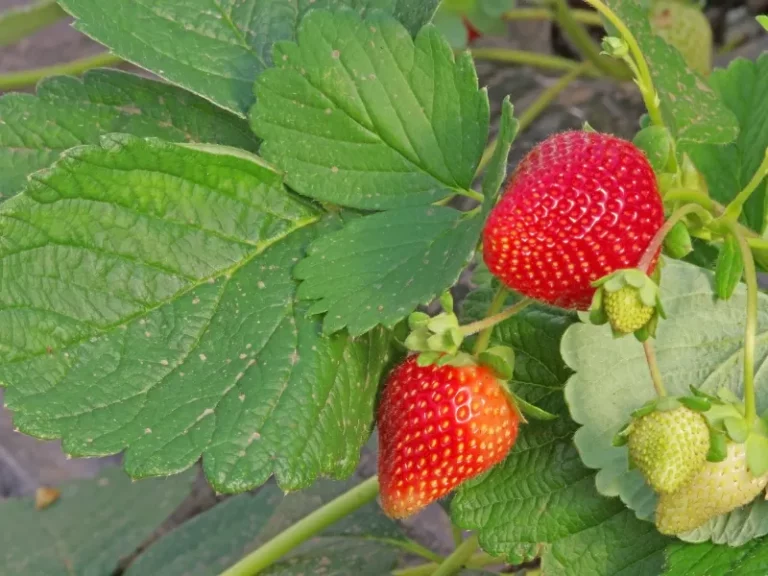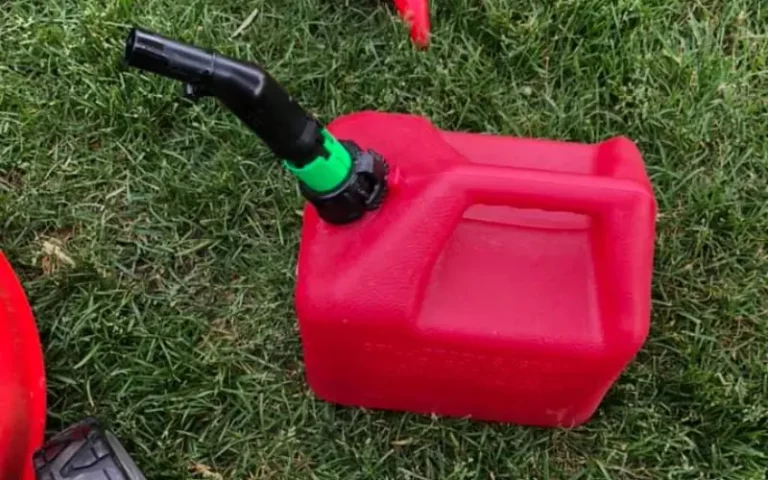How to Identify and Control Nutsedge or Nutgrass (Cyperus sp) in Your Lawn
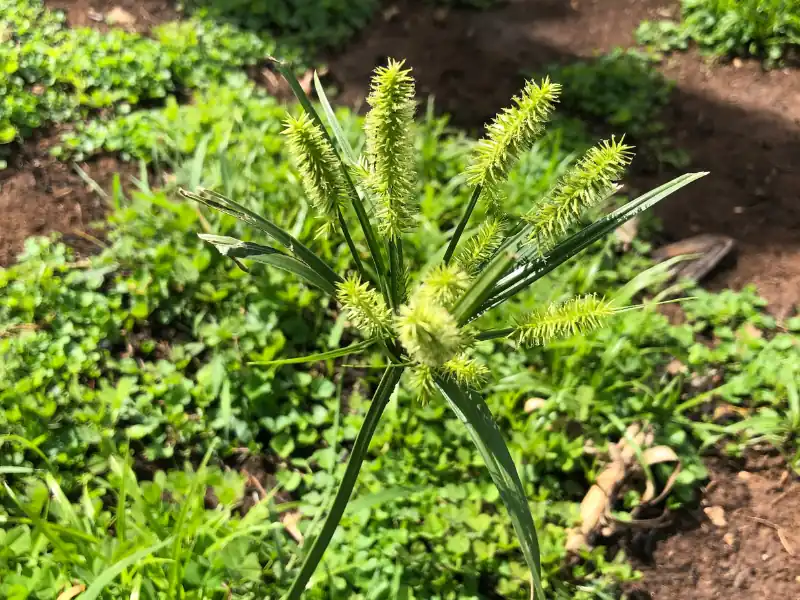
Nutgrass, commonly known as nutsedge, is a persistent, fast-growing, and troublesome perennial weed that can quickly take over any lawn or crop field if left untreated. This stubborn plant earned its name (nutsedge) due to the nut-like tubers that grow underground.
After battling nutsedge invasions in my lawn for years, I thought it’d be a good opportunity to share everything I’ve learned about nutsedge. This includes identifying nutsedge varieties, control methods for eliminating it, and some interesting uses for the weed.
Taxonomy/classification
- Class: Liliopsida
- Subclass: Commelinidae
- Order: Cyperales
- Family: Cyperaceae
- Genus: Cyperus
- Species: Cyperus rotundus, Cyperus esculentus
Nutsedge or nutgrass belongs to a family of flowering plants called Cyperaceae, commonly known as sedges. This family comprises various species, and within the Cyperus genus, nutsedge has two varieties, including the yellow nutsedge (Cyperus esculentus) and the purple nutsedge (Cyperus rotundus).
How can you identify nutsedge?
Below is a photo of the nutsedge I uprooted the other day from my lawn.
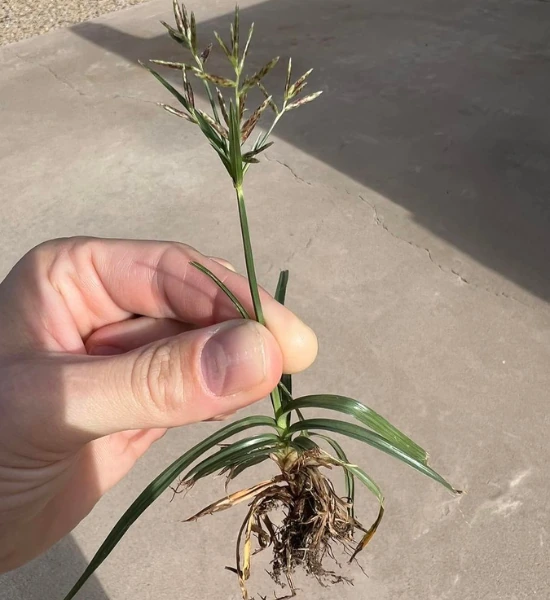
Typically, it looks like grass, but don’t confuse it with grass. Below are the features that can help you identify nutsedge alongside photos to help you visually ID it in your lawn:
Leaves
Nutsedge leaves have a slender and glossy appearance, with a waxy cuticle and a distinct “v” shape along the midrib. The yellow nutsedge variety is yellowish green, while the purple nutsedge has dark green foliage.
Stems
When you roll a nutsedge stem between your fingers, you can feel its unique triangular shape with three sides. It lacks the segmented nodes that you would feel on grass stems.
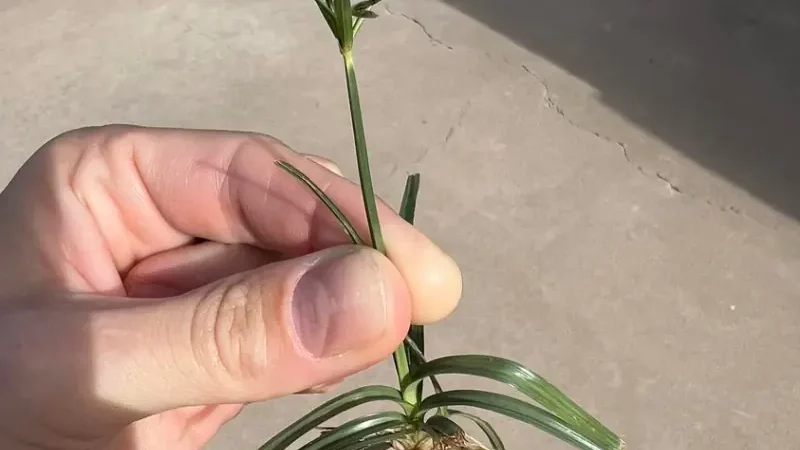
Height
If not mowed or treated, nutsedge can grow up to 3 feet tall. I easily spot them on my lawn since they grow faster than regular grass.
Flowers
The flowers occur in clusters or spikelets at the end of the stem. Below each flower are three long leaf-like bracts. Yellow nutsedge has yellow-brown flowers, while purple nutsedge has reddish-brown flowers. (See photos below)
Roots
Nutsedge has shallow fibrous roots with round tubers or nutlets at the end of the rhizomes that store food. Young nuts are white and turn brown in summer and black when it approaches fall.
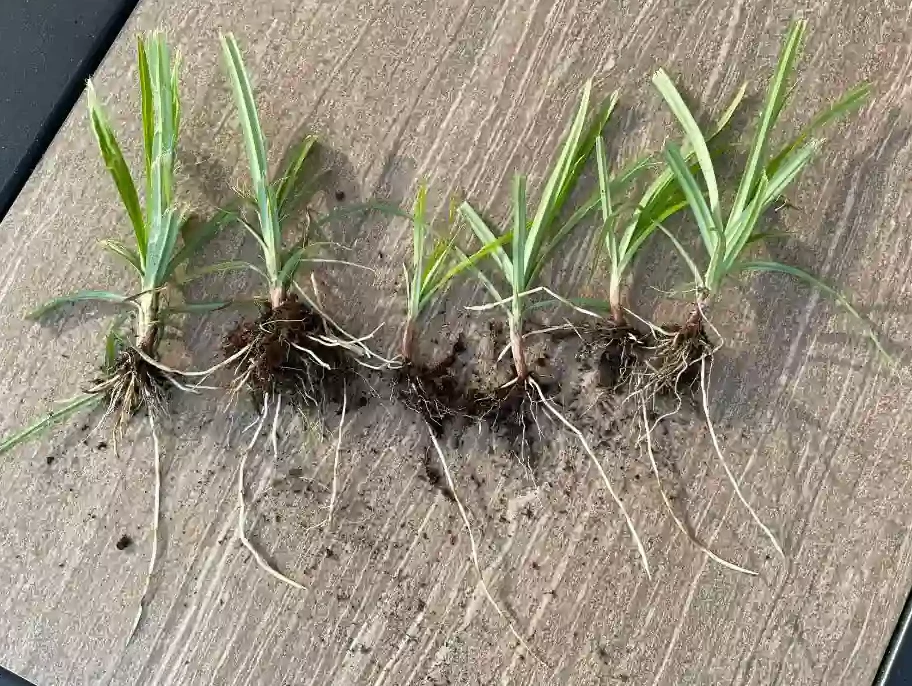
Understanding the spread and growth pattern of nutsedge
Nutsedge uses multiple reproduction methods. These include reproduction by seeds, rhizomes, and tubers. However, it primarily relies on its rhizomes and tubers for a faster and more efficient propagation method than seed dispersal.
Here is a photo of its rhizomes and tubers.
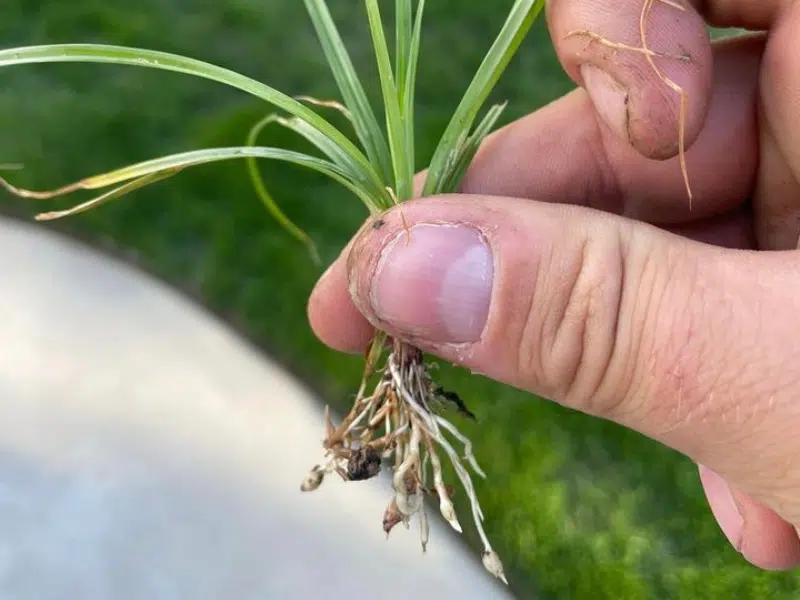
It has a complex underground root system, with roots intertwining and connecting horizontally from one shoot to the next. Just like I have shown in the photo of Nutsedge’s root system above. This underground root network allows the nutsedge to spread rapidly from a single shoot to form dense patches in your lawn.
A study by the University of Missouri revealed that a single nutsedge plant could produce approximately 200 shoots within 8 months. This highlights its vigorous spreading ability.
The life cycle of nutsedge
Nutsedge is a perennial weed whose lifecycle spans across the year. Its germination typically occurs around mid-April and remains active throughout the year, posing a constant challenge in lawns and gardens.
Nutsedge actively grows from spring to fall, utilizing the warm temperatures and ample moisture available. It develops shoots with a unique triangular shape and glossy look above the ground, supported by underground rhizomes and tubers that store energy and help in its growth.
As winter approaches and temperatures drop, nutsedge undergoes a period of dormancy. However, it will resume growth when conditions become favorable again after winter.
Nustedge usually grows on low-lying, moist areas on your lawn, generally along the edges where water passes through to drain the excess water out of the lawn or near leaking sprinkling pipes.
Nustedge varieties
Nutsedge has two primary species: Yellow nutsedge (Cyperus esculentus) and purple nutsedge (Cyperus rotundus).
1. Yellow nutsedge (Cyperus esculentus)
Yellow nutsedge is mostly found in nurseries, turfgrass, and landscapes across North America. It belongs to the Cyperaceae family, a family of flowering plants commonly called sedges.
It has a triangular stem that can help you distinguish it from other grasses and weeds. The stem is nodeless and has a reddish base.
The leaves of yellow nutsedge are relatively narrow, measuring about 5 to 8 mm in width. They have a smooth texture and vary in color from yellowish to light green. They have a glossy texture and lack hair or fuzz.
Yellow nutsedge produces unique flowers in spikelets that cluster at the ends of its stems containing the plant’s seeds.
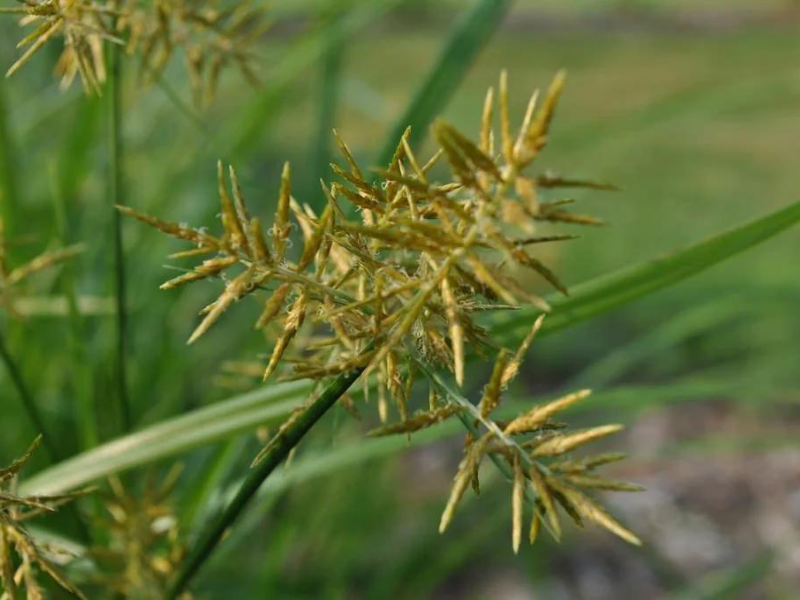
2. Purple nutsedge (Cyperus rotundus)
Purple nutsedge, or coco grass, on the other hand, is commonly found in turf, ornamental areas, and cultivated fields throughout the southeastern United States.
It has slender, round, three-cornered stems which support dark green leaves. The leaves emerge in groups of three, arranged alternately around the triangular base’s stem. Younger purple nutsedge has light green leaves.
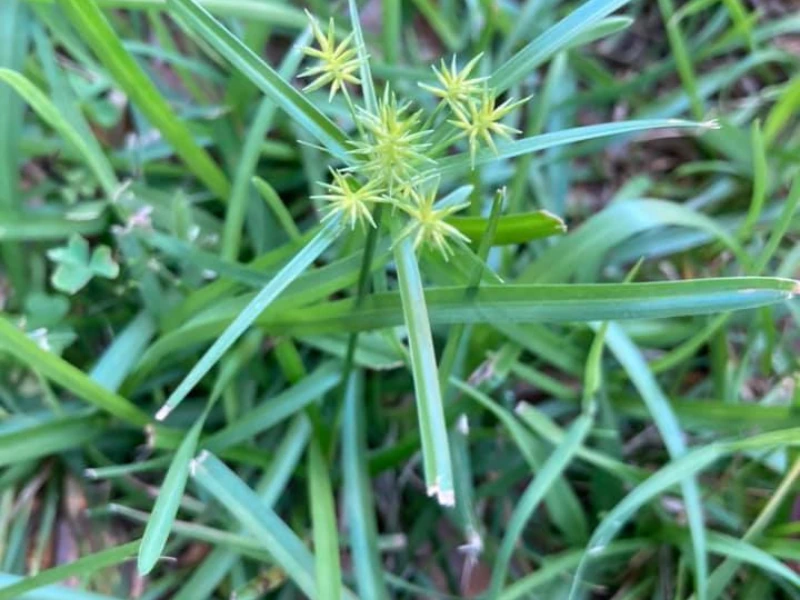
As the purple nutsedge matures, it initially develops white tubers but gradually darkens to a dark brown or black color. These tubers serve as underground storage organs for the plant.
Purple nutsedge produces distinctive purple spikelets in the form of flowers. These spikelets contain the plant’s seeds.
The nutlets of purple nutsedge have a bitter taste compared to yellow nutsedge. This difference in flavor can help you distinguish between the two species.
Below I tabulated the key differences between yellow nutsedge and purple nutsedge for you to have a better understanding of the two:
| Feature | Yellow nutsedge | Purple nutsedge |
| Scientific name | (Cyperus esculentus) | (Cyperus rotundus) |
| Stem shape | Erect, thin, and triangular | Erect, thin and triangular |
| Leaf color | Yellowish to light green | Dark green but shiny |
| Leaf texture | Smooth | Smooth |
| Flower color | Yellow-brown | Reddish-purple |
| Nutlet color | Initially white but turns brown | Initially white, but darkens with age |
| Nutlet taste | Sweet to taste | Bitter compared to yellow nutsedge |
| Native | America | India |
How to get rid of nutsedge
The best time to get rid of nutsedge is during late spring and early summer (in June) while the weed is actively growing and the nutlets are produced.
Below, I’ve discussed the various effective ways of eliminating nutsedge that work for me:
1. Chemical control
Chemical herbicides are reliable since they effectively target and eliminate nutsedge by penetrating the soil, reaching the hidden nutlets for long-lasting control. Unlike hand-pulling, which I don’t recommend since the ones that I hand-pulled from my lawn later on resprouted and multiplied.
The best nustedge killers are Sedgehammer, Certainty, and Ortho Nutsedge Killer. When you use these potent chemicals in combination with a non-ionic surfactant, you effectively eliminate nutsedge without causing harm to your grass or desired plants. They target the visible seed heads and the hidden root system of nutsedge.
Let’s look at each product, their active ingredients, and how they work to kill nutsedge.
1. Sedgehammer herbicide
Sedgehammer post-emergent herbicide has proven to eliminate yellow and purple nutsedges and other lawn weeds, such as green Kyllinga, which is almost similar to nutsedge in appearance.

The herbicide comes in two varieties: Sedgehammer and Sedgehammer plus (+)
- Sedgehammer is available in 28-gram bottles, providing a powdered herbicide that can be mixed with water and sprayed to eliminate nutsedge from your lawn. For enhanced effectiveness, add ⅓ of an ounce of surfactant per gallon of the mixture to help penetrate the waxy cuticle of the nutsedge leaves.
- Sedgehammer Plus (+), however, comes in two 13.5g packets that make about 1 gallon of herbicide to be sprayed on about 1000 square feet of space. The best part of this variety is that it already contains a surfactant.
Both Sedgehammers contain halosulfuron-methyl as the active ingredient. In Sedgehammer, the active ingredient is 75% by WT (weight percentage), while in Sedgehammer plus (+), it is 5% by WT. When applied, it targets the acetolactate synthase enzyme, leading to a quick stoppage in cell division and the growth of nutsedge plants in their roots and shoots.
Here is how you can use sedgehammer to get rid of nutsedge:
- Make a mixture of the herbicide with water as per the guidelines on the packaging. Remember that while using sedgehammer you’ll have to add a surfactant such as Nanotek Surfactant.
- Place the mixture in a pump sprayer, shake it well, and close the top tightly.
- Once ready to spray, wear long pants, shoes, gloves, and a long sleeve shirt.
- While spraying, wet the target weeds thoroughly.
If a second treatment is required, do it 6 to 10 weeks after the first application.
Pro tips: To maximize absorption, don’t mow your lawn three days before and after applying Sedgehammer. Additionally, avoid spraying if rain is expected within 4 hours and be cautious not to spray desired plant foliage.
After around two weeks, the leaves were yellowing and wilting from my application, and the plant stopped spreading. This is what it looked like. (See photo)
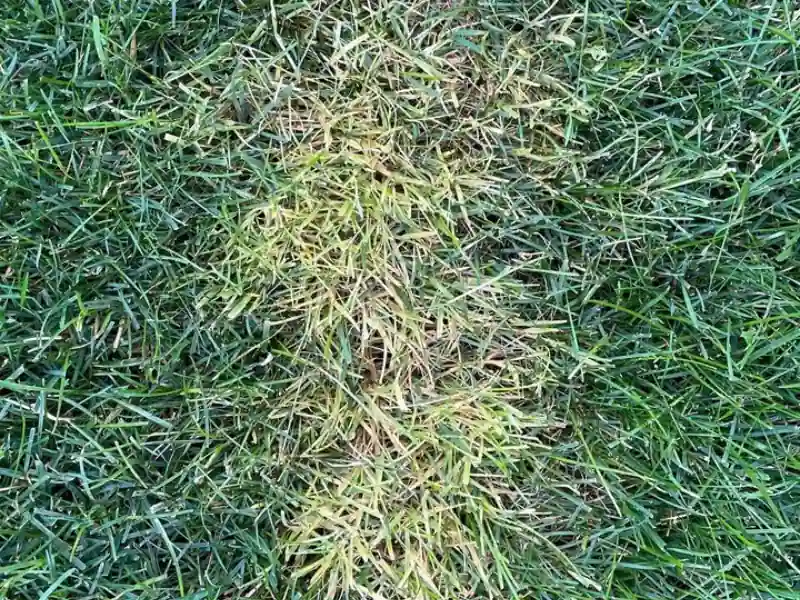
Then the nutsedges browned and died within a month. After that, you can mow or hand-pull the dead nutsedge.
Sedgehammer is suitable for use in both cool and warm season turfgrass, making it compatible with a range of grass types such as fine fescue, tall fescue, Bermudagrass, Kentucky bluegrass, St. Augustinegrass, and perennial ryegrass.
2. Certainty
Certainty contains 75% WT Sulfosulfuron as its active ingredient, which can control both purple and yellow nutsedge annual sedges, annual sedges, Kyllina, and broadleaf weeds such as dandelions, bedstraw, chickweed, white clover, and ground ivy.
The herbicide is packaged in an 80-gram bottle containing the powder and a measuring scoop.
Here is how to use certainty to get rid of nutsedge:
- For approximately 1000 sq. ft of spraying area, mix 4 small scoops of certainty with a gallon of water and ⅓ of an ounce of a nonionic surfactant.
- Then, pure the mixture in a spraying pump and shake well.
- Wear protective clothing, then begin to spray. While spraying, keep the nozzle spray close to the ground and spray till you soak the ground slightly.
- Then, allow the mixture to dry for about 3 hours before you irrigate the sprayed area.
Pro tip: Best apply certainty early in the morning and avoid mowing your lawn for the next two days.
In about two weeks, the nutsedge leaves started to brown out and had stopped growing past the level of the grass on my lawn. That showed that certainty works. Then, after a month, all nutsedge had browned out fully and died.
Certainty is compatible with the following turf grasses, such as bermudagrass, tall fescue, Bahiagrass, Seashore paspalum, Buffalograss, perennial ryegrass, St. Augustinegrass, Centipedegrass, Kikuyugrass, and Zoysiagrass.
3. Ortho® Nutsedge Killer Ready-To-Spray
Third on our product list for herbicides that I used to kill nutsedge is the Ortho nutsedge killer.
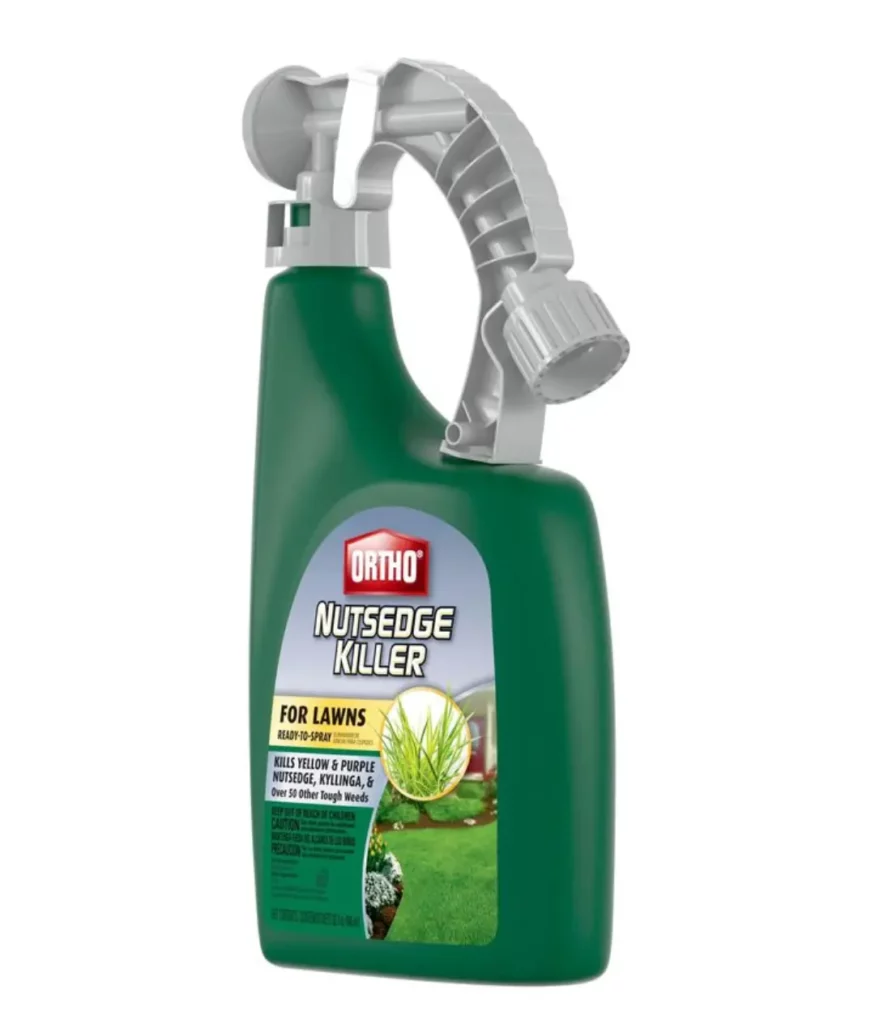
This product comes in a ready-to-spray form, and you won’t have to mix substances at any point. The bottle weighs about 1 kg and contains approximately 1 liter of liquid herbicide, which can be used on about 5000 sq. ft of spraying space.
Here is how to use Ortho® Nutsedge Killer:
- Wear protective clothing.
- Attach the sprayer to your water hose.
- Turn on the water.
- Slide the tab on the applicator to the ON position.
- Then, walk around while spraying the herbicide evenly on the area.
- Then, allow the sprayed area for about 1 hour to dry before irrigating.
Although unnecessary, you can add about ⅓ of an ounce of surfactant into the bottle and spray the nutsedge to increase effectiveness.
Ortho works quickly; within one day, the nutsedge started to turn brown. Then, within a month, the sprayed area was nutsedge-free.
Ortho Nutsedge Killer for Lawns controls purple and yellow nutsedge (nutgrass), kyllinga, wild onion and garlic, dandelion, purslane, spurge, redroot, pigweed, broadleaf plantain, and other broadleaf weeds. It is also suitable for many Northern and Southern grass types.
Pro tip: Don’t spray the product on flowers or garden vegetables. Also, don’t apply on turfgrasses not specified on the label.
Apart from the herbicides mentioned above, we also use Tenacity to kill yellow nutsedge in lawns that are tolerant to its active ingredient, Mesotrione.
2. Natural control
You can check this article here: natural control methods you can use to get rid of nutsedge. I have explained in detail how you can control nutsedge naturally.
Despite that, here are the ways you can control nutsedg naturally:
- Pruning: You can regularly trim the shoots while mowing to prevent them from developing into mature plants.
- Uprooting: Use a shovel to dig out the entire nutsedge plant removing all the underground rhizomes and tubers. This method works best when they are young and yellow with a less established root system. Once the shoots turn green, it signifies that the tubers are well-established and can regenerate. CAUTION: However, I discourage this method since some root tubers might be left behind, which will regrow within a few months.
- Mulching: Cover the nutsedge growing area with a thick layer of leaves, wood chips, straw, or compost to kill them. However, The stems and leaves of nutsedge can easily break through the mulch to access sunlight, allowing the plant to continue growing.
Caution: These natural methods may take time and repeated applications to effectively control nutsedge.
How to prevent nutsedge from growing in your lawn
- Reduce soil compaction: Improve soil drainage by aerating the soil during spring and fall. This process helps to make it more difficult for nutsedge to sprout and grow.
- Promote a thick lawn or a dense plant cover: A thick vegetation cover limits the available space and resources for nutsedge to thrive.
- Adopt a proper watering schedule: Implement a consistent watering schedule and avoid overwatering since nutsedge thrives in moist conditions.
- Mow high: Set your mower height between 3 to 3.5 inches above the ground. Longer grass shades out nutsedge and limits its access to sunlight, gradually weakening and suffocating it. Alternatively, in crop fields, grow crops that can grow taller than three feet to shade out nutsedge.
- Regular monitoring and manual removal: Inspect your growing space and uproot out any emerging nutsedge shoots. Early detection and removal will help prevent the spread of nutsedge.
- Tilling in crop fields: Tilling the soil to a depth of about 6 inches during summer can help expose and allow sunlight to scorch nutsedge tubers.
Uses of nutsedge
Despite nutsedge being a noxious weed, it has some good uses. Here are the benefits of nutsedge:
- Medicinal Purposes:
- Yellow nutsedge has traditionally been used as a herb to treat urinary disorders, including unpleasant urine smell and pain during urination. A popular remedy involves uprooting the plant, washing it well, and boiling it with clean water along with lemon grass for about 15 minutes. Then consume the resulting boiled water.
- Purple nutsedge has antioxidant properties that can help reduce blood sugar levels and inhibit the growth of bacteria, including those responsible for causing dental cavities. Moreover, this plant may aid in weight loss by breaking down fat.
- Animal feed: The tubers and foliage of yellow nutsedge can be used as animal feed, providing a source of carbohydrates and nutrients for livestock.
- Soil improvement: Nutsedge roots can enhance soil structure, prevent erosion, improve moisture retention, and increase organic matter content in the soil.
I hope you found this article useful and educative. If you have questions, comment below or email me at briankapperman@gmail.com
FAQs
1: Is pulling nutsedge a good practice or bad?
Pulling nutsedge can be effective, especially when done early and consistently. However, ensure that you remove the plant entirely, including all the underground tubers, to prevent regrowth.
2: How can I get rid of nutsedge permanently?
Achieving permanent removal of nutsedge can be challenging due to its persistent nature. However, if you combine strategies such as manual pulling, using herbicides formulated for nutsedge, improving soil conditions, and promoting a healthy lawn or dense plant cover, you might kill nutsedge permanently.
3. Can pre-emergents stop nutsedge growth effectively?
Pre-emergents can stop nutsedge from sprouting from seeds, but they won’t fully prevent its return. Since already established nutsedge spreads majorly by underground tubers and rhizomes that pre-emergents cannot affect.
References
- University of Florida: Purple nutsedge as an invasive
- University of Missouri: Yellow nutsedge and Purple nutsedge
- University of Nebraska: Battling Yellow Nutsedge

